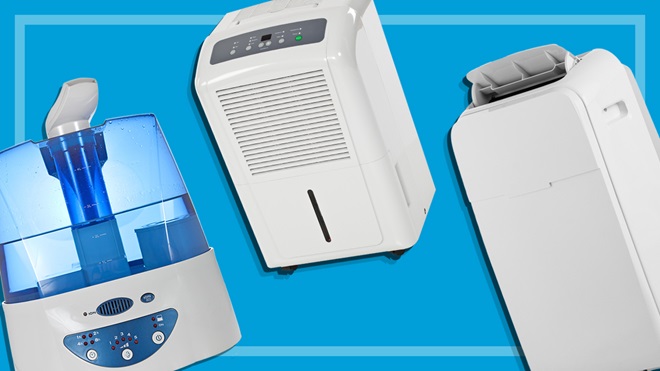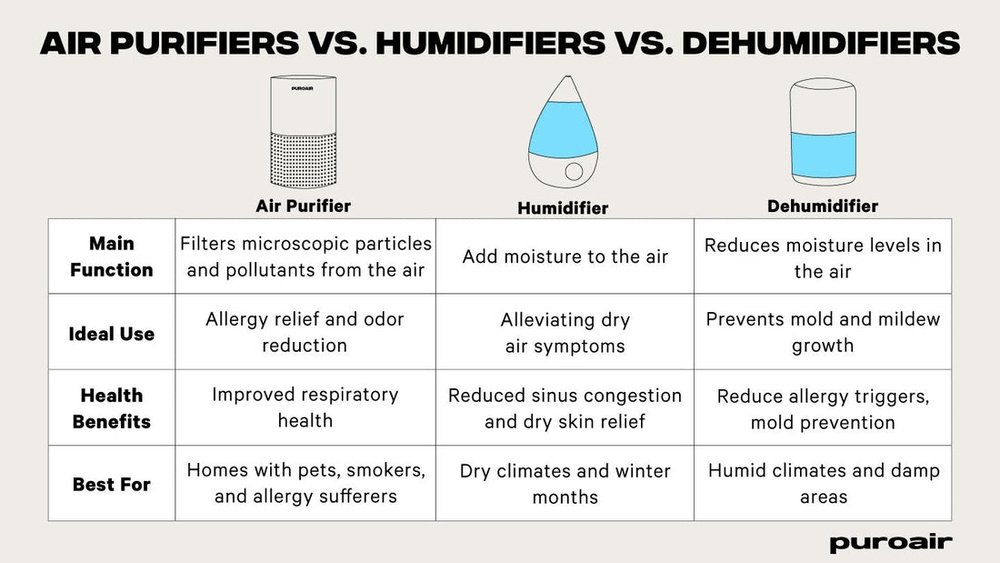Have you ever wondered why your room feels stuffy, dry, or just not quite right? It might be time to consider a humidifier, dehumidifier, or air purifier—but which one do you actually need?
Understanding the difference between these devices can make a huge impact on your comfort and health. You’ll discover exactly how each one works and which is best for your space. Keep reading, because choosing the right device could change the way you breathe and feel every day.
Humidifier Basics
Humidifiers add moisture to dry air inside your home or office. Dry air can cause discomfort like dry skin, throat irritation, and even cold symptoms. Using a humidifier helps keep the air moist and comfortable. It can improve breathing and protect your furniture from cracking.
Understanding how humidifiers work and the types available helps you choose the right one. This section covers the basics of humidifiers and their benefits.
How Humidifiers Work
Humidifiers release water vapor or steam into the air. This increases the humidity level in a room. Some use a fan to blow moisture, while others heat water to create steam. The added moisture helps prevent dryness in the air.
Most humidifiers have a water tank that you fill. The device then turns the water into mist or steam. This process raises humidity and makes the air easier to breathe.
Types Of Humidifiers
There are several types of humidifiers. The common ones include ultrasonic, evaporative, and steam vaporizers. Ultrasonic humidifiers use vibrations to create a fine mist. Evaporative models use a wick filter and fan to evaporate water. Steam vaporizers heat water to produce steam.
Each type suits different needs and rooms. Ultrasonic humidifiers are quiet and energy-efficient. Evaporative ones are good for larger spaces. Steam vaporizers can kill germs by boiling water.
Benefits Of Using Humidifiers
Humidifiers help reduce dryness in the air. This eases dry skin, chapped lips, and irritated eyes. They also relieve symptoms of colds and allergies. Moist air can make breathing easier and improve sleep quality.
Humidifiers protect wooden furniture and musical instruments from cracking. They also reduce static electricity in the air. Using a humidifier creates a healthier and more comfortable environment indoors.

Credit: getpuroair.com
Dehumidifier Essentials
Dehumidifiers help control moisture in the air. They reduce dampness and prevent mold growth. This makes rooms more comfortable and healthier to live in.
Understanding how dehumidifiers work and their types helps you choose the right one. Knowing their benefits also shows why they matter in many homes.
How Dehumidifiers Work
Dehumidifiers pull moist air from the room. Inside, the air cools down, and water turns into liquid. This water collects in a tank or drains out. The dry air then returns to the room.
Types Of Dehumidifiers
There are two main types: refrigerant and desiccant. Refrigerant models use cooling to remove moisture. Desiccant ones use special materials that absorb water. Each type fits different room sizes and needs.
Advantages Of Dehumidifiers
Dehumidifiers stop mold and dust mites from growing. They improve air quality and comfort. These devices protect furniture and walls from damage. Using one can also reduce allergy symptoms.
Air Purifier Insights
Air purifiers help keep indoor air clean and fresh. They remove dust, pollen, smoke, and other tiny particles. This makes the air easier to breathe. Many people use air purifiers to reduce allergy and asthma symptoms. They also help fight germs and odors in the home.
Understanding how air purifiers work and the types available can help you choose the best one. Knowing their health benefits shows why they are useful in many homes.
How Air Purifiers Work
Air purifiers pull air into the machine using a fan. Inside, the air passes through filters that trap particles. Some purifiers use special technology to kill germs or neutralize odors. The clean air then flows back into the room. This process repeats, improving air quality over time.
Common Air Purifier Types
HEPA filters are very popular for removing tiny particles. Carbon filters help reduce bad smells and gases. Some purifiers use UV light to kill bacteria and viruses. Others use ionizers, which make particles stick to surfaces or each other. Each type suits different needs and environments.
Health Benefits Of Air Purifiers
Air purifiers reduce allergens like dust and pollen. This helps people with allergies breathe better. They can also lower asthma triggers in the air. Removing smoke and harmful chemicals supports lung health. Cleaner air may improve sleep and overall comfort at home.

Credit: www.choice.com.au
Key Differences
Understanding the key differences between a humidifier, dehumidifier, and air purifier helps you choose the right device. Each device serves a unique role in improving indoor air quality. Knowing their differences can make your home healthier and more comfortable.
Purpose And Function
A humidifier adds moisture to dry air. It helps reduce dryness that can cause skin irritation or sore throats. A dehumidifier removes excess moisture from the air. It prevents mold growth and reduces dampness. An air purifier cleans the air by removing dust, pollen, smoke, and other particles. Each device targets a specific problem in the air.
Ideal Usage Environments
Use a humidifier in dry climates or during winter when air gets dry. A dehumidifier works best in humid areas, basements, or places prone to moisture. Air purifiers are ideal for homes with allergies, pets, or smokers. They are helpful in any space with poor air quality.
Maintenance And Costs
Humidifiers require regular cleaning to prevent bacteria and mold buildup. Dehumidifiers need emptying of collected water and occasional filter changes. Air purifiers require filter replacements to work effectively. Humidifiers and dehumidifiers often use more electricity than air purifiers. Costs vary depending on brand, size, and features.
Choosing The Right Device
Choosing the right device for your indoor air quality is important. Each device serves a different purpose. Knowing what you need helps you decide.
Assessing Your Air Quality Needs
Check your home’s air for moisture and pollutants. Is the air too dry or too wet? Do you notice dust, smoke, or bad smells? Use a humidity meter and air quality monitor if possible. This helps you understand if you need a humidifier, dehumidifier, or air purifier.
Combining Devices For Best Results
Sometimes one device is not enough. A humidifier adds moisture to dry air. A dehumidifier removes extra moisture from damp air. An air purifier cleans dust, allergens, and germs. Using two or more devices together can improve your air quality better. For example, a dehumidifier plus an air purifier works well in damp, polluted spaces.
Tips For Effective Use
Place devices in rooms where you spend most time. Clean filters regularly to keep devices working well. Follow the manufacturer’s instructions for best results. Monitor air quality often to adjust settings. Turn off devices when air reaches the right balance. This saves energy and extends device life.

Credit: www.differencebetween.net
Frequently Asked Questions
What Is The Main Purpose Of A Humidifier?
A humidifier adds moisture to dry air. It helps relieve dryness in skin, throat, and nasal passages. It’s useful in winter or dry climates to maintain comfortable humidity levels indoors.
How Does A Dehumidifier Improve Indoor Air Quality?
A dehumidifier removes excess moisture from the air. This prevents mold growth and reduces allergens. It helps maintain a healthy environment, especially in damp areas like basements.
Can An Air Purifier Remove Humidity From The Air?
No, an air purifier does not remove humidity. It filters out airborne particles like dust, pollen, and smoke. Its main goal is to improve air cleanliness, not control moisture.
When Should I Use A Humidifier Versus A Dehumidifier?
Use a humidifier when indoor air is too dry. Use a dehumidifier when air is overly humid. Both devices help maintain ideal indoor humidity for comfort and health.
Conclusion
Humidifiers add moisture to dry air. Dehumidifiers remove extra moisture to prevent dampness. Air purifiers clean dust, pollen, and other particles. Each device serves a different purpose for your home. Choose one based on your specific needs. Healthy air improves comfort and well-being.
Understanding these differences helps you breathe easier. Keep your indoor air balanced and clean. Simple steps can make a big difference. Clear air, comfortable humidity—feel the change every day.

